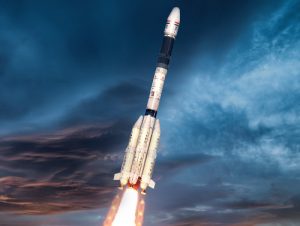 GSLV-F05, India’s Geosynchronous Satellite Launch Vehicle, equipped with the indigenous Cryogenic Upper Stage (CUS), successfully launched the country’s weather satellite INSAT-3DR into a Geosynchronous Transfer Orbit (GTO).
GSLV-F05, India’s Geosynchronous Satellite Launch Vehicle, equipped with the indigenous Cryogenic Upper Stage (CUS), successfully launched the country’s weather satellite INSAT-3DR into a Geosynchronous Transfer Orbit (GTO).
The launch took place from the Second Launch Pad at the Satish Dhawan Space Centre SHAR (SDSC SHAR), Sriharikota, the spaceport of India. This was the first operational flight of GSLV equipped with CUS and the fourth to carry the indigenous CUS.
Today’s GSLV flight was the third consecutive success achieved by GSLV carrying indigenous CUS and the 2,211 kg INSAT-3DR is the heaviest satellite to be launched from the Indian soil.
In its oval shaped GTO, the INSAT-3DR satellite is now orbiting the Earth with a perigee (nearest point to Earth) of 169.76 km and an apogee (farthest point to Earth) of 36,080.5 km with an orbital inclination of 20.62 deg with respect to the equator.
After a 29 hour 40 minutes countdown, the 415 tonne, 49 m tall GSLV-F05 carrying INSAT-3DR, lifted off at the rescheduled time of 16:50 Hrs IST. The 40 minute delay in the launch was due to an anomaly observed in the functioning of a pressure release valve in the liquid Oxygen filling ground segment which was resolved later.
Soon after its injection into GTO, the solar array of INSAT-3DR was automatically deployed and the Master Control Facility (MCF) at Hassan in Karnataka took control of the satellite.
INSAT-3DR is an advanced meteorological (weather observation) satellite built by India to provide a variety inputs essential for accurate weather forecasting. For this, it is equipped with three payloads (instruments), namely, a Multispectral Imager, Sounder and weather Data Relay Transponder. INSAT-3DR also carries a satellite aided Search and Rescue Transponder that picks up and relays alert signals originating from distress beacons of maritime, aviation and land based users.






